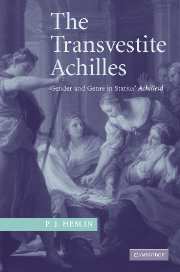Book contents
2 - The Design of the Achilleid
Published online by Cambridge University Press: 29 October 2009
Summary
If anybody should find fault with this story, i.e. How could Pyrrhus son of Achilles be at the battle of Troy if the Greeks were only ten years and six months and twelve days at the siege, and you think it was because of the abduction of Helen, daughter of Leda, by Alexander that that war of the Greeks was begun. Give him this answer, i.e. that Thetis daughter of Nereus brought Achilles to Scyros in order to hide him immediately after the abduction of Helen, daughter of Leda. And shortly afterward Achilles was on the island when Pyrrhus was begotten by him upon Deidamia daughter of Lycomedes. It was long after that the Greeks finished assembling and sent messengers to seek Achilles as is told here.
From a twelfth-century Irish version of the AchilleidTheAchilleid is a coherent and polished piece of work, but these virtues have often been overlooked on account of its unfinished state. The usual presumption, which is almost certainly correct, is that Statius' death interrupted his work on it. Because the poem as we have it is in a curtailed state, it will be necessary to consider the circumstances of its composition before we turn to questions of its form and genre. The Achilleid is often referred to as a “fragment,” but this is a misleading label. This term, as it is used when speaking of ancient literature, usually describes a piece of writing that has become seriously mutilated in the course of its transmission to us.
- Type
- Chapter
- Information
- The Transvestite AchillesGender and Genre in Statius' Achilleid, pp. 57 - 104Publisher: Cambridge University PressPrint publication year: 2005



